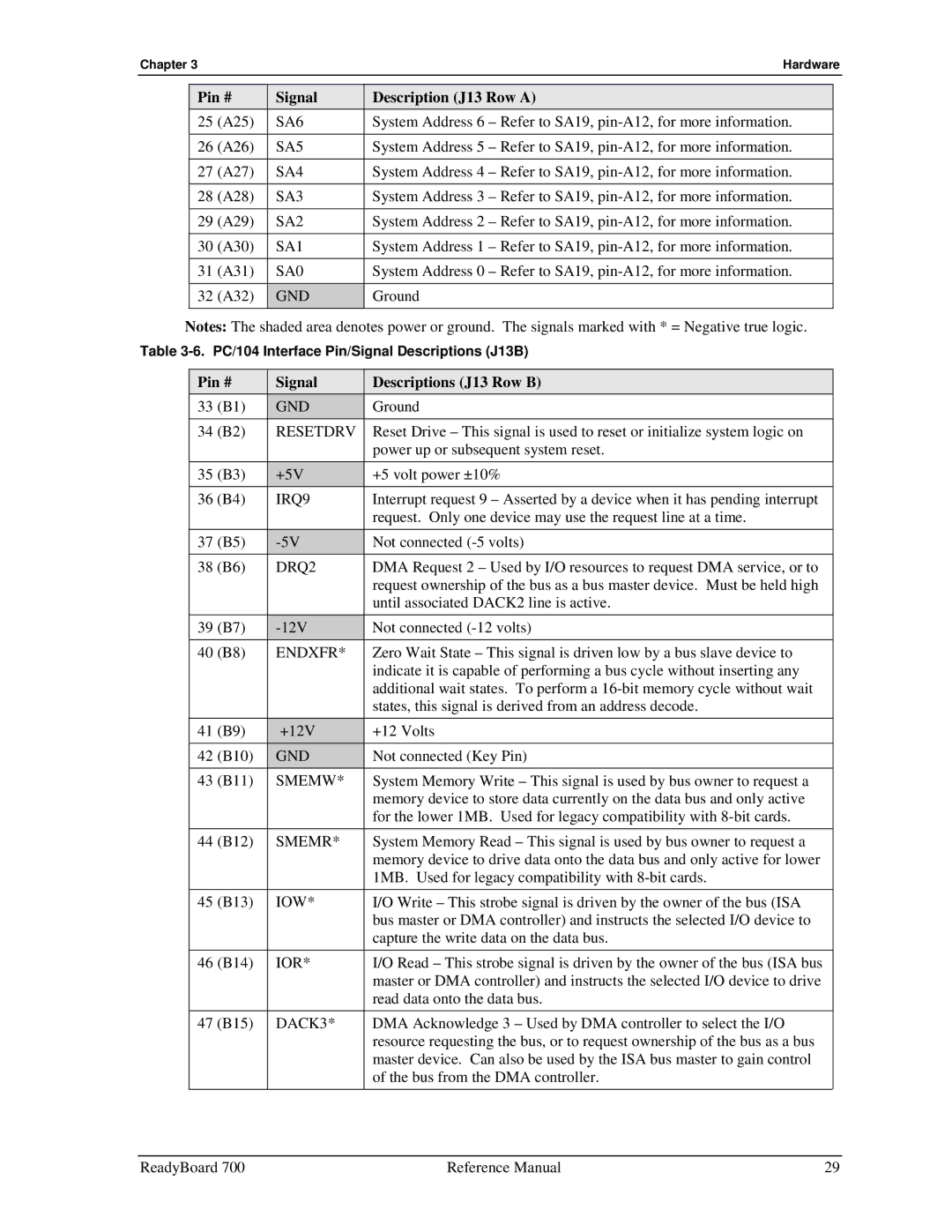Chapter 3 |
| Hardware | ||
|
|
|
|
|
| Pin # | Signal | Description (J13 Row A) |
|
| 25 (A25) | SA6 | System Address 6 – Refer to SA19, |
|
|
|
|
|
|
| 26 (A26) | SA5 | System Address 5 – Refer to SA19, |
|
|
|
|
|
|
| 27 (A27) | SA4 | System Address 4 – Refer to SA19, |
|
|
|
|
|
|
| 28 (A28) | SA3 | System Address 3 – Refer to SA19, |
|
|
|
|
|
|
| 29 (A29) | SA2 | System Address 2 – Refer to SA19, |
|
|
|
|
|
|
| 30 (A30) | SA1 | System Address 1 – Refer to SA19, |
|
|
|
|
|
|
| 31 (A31) | SA0 | System Address 0 – Refer to SA19, |
|
|
|
|
|
|
| 32 (A32) | GND | Ground |
|
|
|
|
|
|
Notes: The shaded area denotes power or ground. The signals marked with * = Negative true logic.
Table
Pin # | Signal | Descriptions (J13 Row B) | |
33 | (B1) | GND | Ground |
34 | (B2) | RESETDRV | Reset Drive – This signal is used to reset or initialize system logic on |
|
|
| power up or subsequent system reset. |
35 | (B3) | +5V | +5 volt power ±10% |
36 | (B4) | IRQ9 | Interrupt request 9 – Asserted by a device when it has pending interrupt |
|
|
| request. Only one device may use the request line at a time. |
37 | (B5) | Not connected | |
38 | (B6) | DRQ2 | DMA Request 2 – Used by I/O resources to request DMA service, or to |
|
|
| request ownership of the bus as a bus master device. Must be held high |
|
|
| until associated DACK2 line is active. |
39 | (B7) | Not connected | |
40 | (B8) | ENDXFR* | Zero Wait State – This signal is driven low by a bus slave device to |
|
|
| indicate it is capable of performing a bus cycle without inserting any |
|
|
| additional wait states. To perform a |
|
|
| states, this signal is derived from an address decode. |
41 | (B9) | +12V | +12 Volts |
42 | (B10) | GND | Not connected (Key Pin) |
43 | (B11) | SMEMW* | System Memory Write – This signal is used by bus owner to request a |
|
|
| memory device to store data currently on the data bus and only active |
|
|
| for the lower 1MB. Used for legacy compatibility with |
44 | (B12) | SMEMR* | System Memory Read – This signal is used by bus owner to request a |
|
|
| memory device to drive data onto the data bus and only active for lower |
|
|
| 1MB. Used for legacy compatibility with |
45 | (B13) | IOW* | I/O Write – This strobe signal is driven by the owner of the bus (ISA |
|
|
| bus master or DMA controller) and instructs the selected I/O device to |
|
|
| capture the write data on the data bus. |
46 | (B14) | IOR* | I/O Read – This strobe signal is driven by the owner of the bus (ISA bus |
|
|
| master or DMA controller) and instructs the selected I/O device to drive |
|
|
| read data onto the data bus. |
47 | (B15) | DACK3* | DMA Acknowledge 3 – Used by DMA controller to select the I/O |
|
|
| resource requesting the bus, or to request ownership of the bus as a bus |
|
|
| master device. Can also be used by the ISA bus master to gain control |
|
|
| of the bus from the DMA controller. |
ReadyBoard 700 | Reference Manual | 29 |
